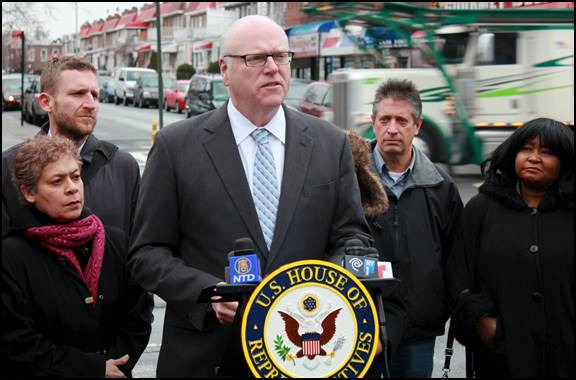
Rep. Albio Sires has his New Opportunities for Bicycle and Pedestrian Infrastructure Financing Act (HR 3978). Rep. Earl Blumenauer has his Bicycle and Pedestrian Safety Act (HR 3494). And now, Rep. Joe Crowley has unveiled his Pedestrian Fatalities Reduction Act.
The New York City Democrat, a supporter of Vision Zero, made the announcement yesterday morning in Queens, which suffers a high rate of pedestrian crashes. He was flanked by street safety advocates and public officials.
States are currently required to submit comprehensive, statewide Strategic Highway Safety Plans to the Federal Highway Administration in order to receive federal highway safety funds. Crowley says the SHSP “is used by state departments of transportation to outline safety needs and determine investment decisions” but that “surprisingly, federal law does not require SHSPs to include statistics on pedestrian injuries and fatalities.”
His bill [PDF] would require states to report on the rate of fatalities and serious injuries among pedestrians and "users of nonmotorized forms of transportation." If those numbers go up, a state would have to explain in its SHSP how it will address the problem.
While Blumenauer’s bill issues a stronger mandate for a separate performance measure for bicycle and pedestrian safety, U.S. DOT has said that for now, it’s not planning to implement one -- but it’s put out a call for input on how such a measure could work. Crowley’s bill could be viewed as one stab at an answer.
However, this bill doesn’t include even the flabby “consequences” that U.S. DOT seeks to impose on states that don't meet their safety targets, like the requirement to use safety money to address safety concerns. Crowley just wants to hear from the states how they’ll try to do better next time. Though the SHSP is required for federal funding, nowhere in his bill does it state that significant action or improvement is required to get that federal funding.
Still, it begins to put the safety of people biking and walking on the radar of state DOTs, which are often more accustomed to looking at the entire roadway ecosystem from a windshield perspective.
Several street safety organizations have enthusiastically endorsed the bill, and Patrick Malone from Rep. Blumenauer’s office said that although they aren’t coordinating their efforts, their two bills are “extremely complementary of each other.”
“Having multiple angles and multiple representatives coming out with bills about bike safety really shows, as Rep. Blumenauer would say, the ‘bike-partisan’ nature of Congress,” Malone said. “Who ever thought there would be competing, or overlapping, bicycle safety bills? It’s a new day.”
While neither Blumenauer’s bill not Sires’ bill have gone anywhere since being introduced in November and January, respectively, that’s not necessarily a problem. Bills like these are often introduced as “markers,” to go on record requesting a provision’s inclusion in the next transportation bill. In this case, the next bill is due by October 1. Crowley's bill hasn't been formally introduced yet.





